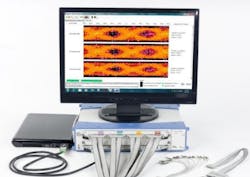Navy orders seven P-8A Poseidon advanced maritime patrol jets from Boeing in $1.4 billion contract
The P-8A is a specially hardened and reinforced version of the Boeing 737 passenger jet, and is designed to operate at extremely low altitudes over the ocean during close-in searches for potentially hostile submarines. The P-8A is designed to withstand the rigors of low-altitude turbulence and exposure to salt spray.
Navy officials plan to use the P-8A in tandem with the Northrop Grumman Northrop Grumman RQ-4N Broad Area Maritime Surveillance (BAMS) unmanned aerial vehicle (UAV) -- a maritime-patrol version of the Global Hawk long-range surveillance UAV. Plans call for using BAMS to detect potentially hostile submarines and surface ships, and upon detection, to call in the P-8A to take a closer look, or to attack the hostile vessels with torpedoes and missiles.
Boeing will build the Poseidon aircraft at its factory in Renton, Wash. The 737 fuselage and tail sections will be built by Spirit AeroSystems in Wichita, Kan., then transferred to Renton where all structural features will be incorporated in sequence during fabrication and assembly.
The P-8A's flight management system and the stores management system has been developed by GE Aviation Systems in Grand Rapids, Mich. (formerly Smiths Aerospace). The cabin has as many as seven operator consoles.
The Poseidon's MX-20HD digital electro-optical and infrared (EO/IR) multi-spectral sensor turrets come from L-3 Communications Wescam in Burlington, Ontario. The MX-20HD is gyro-stabilized and can have as many as seven sensors including infrared, CCDTV, image intensifier, laser rangefinder and laser illuminator.
The aircraft has the upgraded APS-137D(V)5 maritime surveillance radar and signals intelligence (SIGINT) system from the Raytheon Co. Space and Airborne Systems (SAS) segment in McKinney, Texas. The APS-137D(V)5 radar, which is installed on the P-8's enlarged nose fairing, provides synthetic aperture radar (SAR) for imaging stationary ships and small vessels and for coastal and overland surveillance, and high resolution imaging synthetic aperture radar (ISAR) for imaging surfaced submarines and fast surface vessels operating in coastal waters.
The P-8A will have the CAE Inc. advanced integrated magnetic anomaly detection (MAD) System. The Navy plans to arm the P-8A with the MK 54 torpedo. The Northrop Grumman Corp. Electronic Systems segment in Baltimore is supplying the electronic warfare self-protection (EWSP) suite which includes Terma AN/ALQ-213(V) electronic warfare management system (EWMS), directional infrared countermeasures (DIRCM) set, radar warning system, BAE Systems countermeasures dispenser.
Boeing will do the work for this contract in Chicago; Greenlawn, N.Y.; Puget Sound, Wash.; Dallas; North Amityville, N.Y.; Cambridge, England; and various locations in and outside the continental U.S.
For more information contact Boeing online at www.boeing.com.
